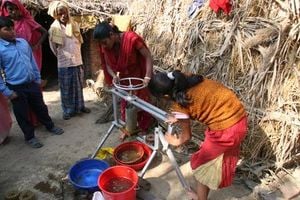(moved more info from biomass) Tag: n |
(added links) Tag: n |
||
| Line 30: | Line 30: | ||
==See also== | ==See also== | ||
* [[Composting toilet]]: feces can also be composted herein, creating compost which is more environmentally friendly | * [[Composting toilet]]: feces can also be composted herein, creating compost which is more environmentally friendly | ||
* [[Elephant dung as a sustainable raw material]] | |||
* [[Fuel Gas from Cow Dung]] | |||
==References== | ==References== | ||
Revision as of 17:57, 11 August 2012
Manure is feces from animals and humans that is used as an organic fertilizer in agricultural fields.
Feces as fuel
Dung is considered to be one of the best fuels for the traditional mud stove for the following reasons:
Problems related to dung as a fuel are:
|
Making Clean Dung Briquettes from manure
Dung washing is a simple process whereby the dung is washed with water, organic matter, fermented paper, sawdust or other additives mixed into the slurry and then the liquid removed via compression. The benefits of washed compressed dung as a fuel source are three fold.
- The chlorine and the silica present in the dung are water soluble and hence can be removed prior to burning. These components contribute a serious health risk for users when burnt.
- The water-soluble fraction of the dung also constitutes the “agriculturally nutritious” aspects of dung and thus can be retained for fertiliser.
- Removal of the silica content, lowers the ash content which inturn allows for the proper flow of air which overall translates to a reduction in the formation of the harmful carbon monoxide.

A briquette press is a tool that can be used to remove the liquid and bind the slurry into solid briquettes. A two stage press has been designed with a hybrid lever and screw compression that produces briquettes fast and efficiently with the minimum of effort. Initially a lever is depressed to a comfortable operating level, then the lever mechanism is locked in place and a secondary screw system further depresses a plunger and applies the additional force necessary to to remove additional moisture. The steel briquette press can be manufactured locally, is easily maintenaned and simple to use. The Briquette chamber can produce four briquettes simultaneously. Having two briquette chambers and base stands allows for increased speed an efficiency as one chamber can be filled whilst the other is being compressed. Briquettes take on average 6 days to dry in dry temperate conditions. [2]
See also
- Composting toilet: feces can also be composted herein, creating compost which is more environmentally friendly
- Elephant dung as a sustainable raw material
- Fuel Gas from Cow Dung